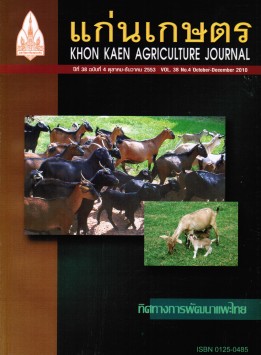Process-based environmental models tree transpiration: A case study of rubber tree (Hevea brasiliensis)
Main Article Content
บทคัดย่อ
Nowadays, tree transpiration (ETree) limitation is investigated in several plant species especially the commercial trees such as the rubber tree. Exceptional tree physiology responds to droughts, the modeling for prediction of ETree is also interest. The aim of this investigation was to evaluate the environmental model for ETreeestimation in all leaf phenology under a wide range of soil water availability and evaporative demand. The results showed that the environmental model called ‘Fsoil_Emax’ (which considered only soil water available affect) produced a reduction of estimated ETree the same as the reducing pattern of actual measured in drought conditions. But there was no variability of estimated ETree when evaporative demand changed. The improving of the environmental model by added the reference evapotranspiration (ET0) which alternated in minimum value between ET0 and Emax, called Fsoil*MIN(Emax;ET0) model, produced a reduction in estimated ETree in both soil drought and low evaporative demand conditions at fully mature leaves stage. Therefore, this model was optimum for estimating transpiration under various conditions. Moreover, the annual accumulated ETree of the improved model slightly overestimated the measured value by 20 mm. However, this model produced estimated ETree at fully mature leaves stage better than during leaf shedding-flushing stage.


